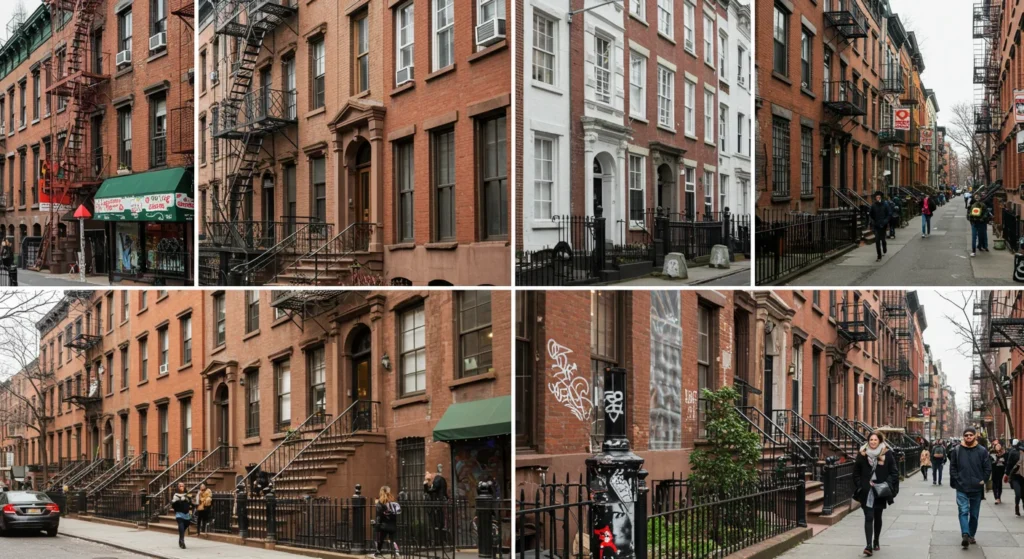Introduction

Brooklyn’s real estate market has undergone a remarkable transformation over the past decade, evolving from an under-the-radar investment opportunity to one of New York City’s most coveted real estate markets. This comprehensive guide will walk you through everything you need to know about investing in Brooklyn real estate, from identifying promising neighborhoods to understanding market dynamics and maximizing your returns.
Current State of Brooklyn’s Real Estate Market
Brooklyn’s real estate landscape continues to evolve, shaped by changing demographics, work patterns, and urban development initiatives. The borough has maintained its appeal to diverse groups, from young professionals seeking vibrant communities to families looking for more space and better value compared to Manhattan.
Key Market Indicators
- Rising property values in emerging neighborhoods
- Strong rental demand across multiple submarkets
- Increasing interest from international investors
- Growing commercial development, particularly in areas like Downtown Brooklyn
- Continued gentrification in previously overlooked neighborhoods
Top Brooklyn Neighborhoods for Real Estate Investment

Williamsburg
- Investment Profile: High entry cost, strong appreciation potential
- Target Demographics: Young professionals, creative workers, luxury buyers
- Key Advantages:
- Prime location with excellent Manhattan access
- Thriving arts and culture scene
- Waterfront properties with skyline views
- Strong rental market
Bed-Stuy (Bedford-Stuyvesant)
- Investment Profile: Moderate entry cost, high growth potential
- Target Demographics: Young families, professionals, first-time homebuyers
- Key Advantages:
- Historic brownstones at relatively affordable prices
- Strong community feel
- Emerging restaurant and retail scene
- Good transportation options
Sunset Park
- Investment Profile: Lower entry cost, long-term appreciation potential
- Target Demographics: Working families, immigrants, young professionals
- Key Advantages:
- Proximity to Industry City
- Waterfront views
- Cultural diversity
- Relatively affordable housing stock
Crown Heights
- Investment Profile: Moderate entry cost, strong rental potential
- Target Demographics: Young professionals, students, diverse communities
- Key Advantages:
- Cultural diversity
- Historic architecture
- Proximity to Prospect Park
- Growing commercial corridors
Bay Ridge
- Investment Profile: Moderate entry cost, stable returns
- Target Demographics: Families, long-term residents
- Key Advantages:
- Suburban feel
- Strong community ties
- Excellent schools
- Waterfront access
READ ALSO: 10 Best Credit Cards for New York Residents in 2025
Investment Strategies for Brooklyn Real Estate
1. Buy-and-Hold Strategy
Long-term property ownership in Brooklyn has historically provided strong returns through appreciation and rental income. This strategy works particularly well in emerging neighborhoods where property values are expected to increase significantly over time.
Key Considerations:
- Property management requirements
- Long-term market trends
- Maintenance costs
- Tenant relationships
- Property tax implications
2. Value-Add Investments
This strategy involves purchasing properties that need renovation or upgrading, then improving them to increase rental income or resale value.
Best Practices:
- Thorough property inspection before purchase
- Accurate renovation cost estimation
- Understanding local building codes and permits
- Working with reliable contractors
- Maintaining project timelines and budgets
3. Multi-Family Properties
Brooklyn’s strong rental market makes multi-family properties an attractive investment option.
Benefits:
- Multiple income streams
- Economy of scale in management
- Built-in diversification
- Potential for significant cash flow
- Tax advantages
Financing Your Brooklyn Real Estate Investment
Traditional Mortgage Options
- Conventional loans
- FHA loans
- VA loans (for eligible veterans)
- Jumbo loans for higher-priced properties
Alternative Financing Methods
- Private money lenders
- Hard money loans
- Partnership structures
- Real estate investment trusts (REITs)
- Crowdfunding platforms
Due Diligence Checklist
Property Analysis
- Historical price trends
- Comparable property sales
- Rental market analysis
- Property condition assessment
- Zoning regulations
- Building violations history
Neighborhood Research
- Development plans
- Transportation improvements
- School quality
- Crime statistics
- Commercial development
- Cultural amenities
Risk Management Strategies
Market Risks
- Diversification across neighborhoods
- Thorough market research
- Conservative financial projections
- Regular market monitoring
Property-Specific Risks
- Comprehensive insurance coverage
- Professional property management
- Regular maintenance schedules
- Emergency fund maintenance
- Tenant screening processes
Legal Considerations
New York-Specific Regulations
- Rent control laws
- Tenant rights
- Building codes
- Zoning restrictions
- Property tax regulations
Entity Structure
- LLC formation
- Partnership agreements
- Tax considerations
- Asset protection strategies
Conclusion
Investing in Brooklyn real estate offers significant opportunities for both newcomers and experienced investors. Success requires careful market analysis, thorough due diligence, and a long-term perspective. By focusing on emerging neighborhoods, maintaining strong property management practices, and staying informed about market trends, investors can build a profitable real estate portfolio in one of New York’s most dynamic boroughs.
Ready to start your Brooklyn real estate investment journey? Connect with local real estate professionals, join investment groups, and begin your neighborhood research today. The sooner you start, the better positioned you’ll be to capitalize on Brooklyn’s continuing growth and development.
Frequently Asked Questions
Q: What is the minimum investment needed to get started in Brooklyn real estate?
A: While it varies by neighborhood, expect to need at least 20-25% down payment for investment properties, plus additional funds for closing costs and potential renovations. In most neighborhoods, this means having at least $150,000-200,000 in available capital.
Q: Which Brooklyn neighborhoods offer the best return on investment?
A: Currently, areas like Sunset Park, Crown Heights, and Bed-Stuy offer strong potential for appreciation while maintaining relatively affordable entry points. However, established areas like Williamsburg and Brooklyn Heights provide stable, long-term returns.
Q: How do I find good investment properties in Brooklyn?
A: Work with experienced local real estate agents, network with other investors, attend real estate auctions, and regularly monitor online listings. Building relationships with local property managers and real estate attorneys can also provide valuable leads.
Q: What are the main risks of investing in Brooklyn real estate?
A: Major risks include market fluctuations, changes in local regulations, property management challenges, maintenance costs, and potential tenant issues. Having a solid risk management strategy and working with experienced professionals can help mitigate these risks.
In another related article, High-End Property Investments: A Finance Devil Guide to Luxury Real Estate in the USA




